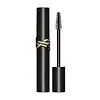Yves Saint Laurent Lash Clash Extreme Volume Mascara Versus Too Faced Better Than Sex Volumizing Mascara
What's inside
What's inside
 Key Ingredients
Key Ingredients

 Benefits
Benefits

 Concerns
Concerns

 Ingredients Side-by-side
Ingredients Side-by-side

Water
Skin ConditioningCI 77499
Cosmetic ColorantBehenyl Behenate
EmollientEthylenediamine/Stearyl Dimer Dilinoleate Copolymer
Skin ConditioningStyrene/Acrylates/Ammonium Methacrylate Copolymer
Cetearyl Alcohol
EmollientStearic Acid
CleansingPalmitic Acid
EmollientPvp
Emulsion StabilisingVp/Eicosene Copolymer
Aminomethyl Propanediol
BufferingPhenoxyethanol
PreservativeCaprylyl Glycol
EmollientButylene Glycol
HumectantMyristic Acid
CleansingSodium Laureth Sulfate
CleansingTetrasodium EDTA
Pentaerythrityl Tetra-Di-T-Butyl Hydroxyhydrocinnamate
AntioxidantPotassium Sorbate
PreservativeIris Florentina Root Extract
MaskingWater, CI 77499, Behenyl Behenate, Ethylenediamine/Stearyl Dimer Dilinoleate Copolymer, Styrene/Acrylates/Ammonium Methacrylate Copolymer, Cetearyl Alcohol, Stearic Acid, Palmitic Acid, Pvp, Vp/Eicosene Copolymer, Aminomethyl Propanediol, Phenoxyethanol, Caprylyl Glycol, Butylene Glycol, Myristic Acid, Sodium Laureth Sulfate, Tetrasodium EDTA, Pentaerythrityl Tetra-Di-T-Butyl Hydroxyhydrocinnamate, Potassium Sorbate, Iris Florentina Root Extract
Water
Skin ConditioningSynthetic Beeswax
Emulsion StabilisingParaffin
PerfumingGlyceryl Stearate
EmollientAcacia Senegal Gum
MaskingButylene Glycol
HumectantOryza Sativa Bran Wax
Skin ConditioningStearic Acid
CleansingPalmitic Acid
EmollientPolybutene
Vp/Eicosene Copolymer
Copernicia Cerifera Wax
Aminomethyl Propanol
BufferingGlycerin
HumectantPvp
Emulsion StabilisingEthylhexylglycerin
Skin ConditioningHydroxyethylcellulose
Emulsion StabilisingDisodium EDTA
Polyester-11
Skin ConditioningCellulose
AbsorbentTrimethylpentanediol/Adipic Acid/Glycerin Crosspolymer
Skin ConditioningPropylene Glycol
HumectantDisodium Phosphate
BufferingPolysorbate 60
EmulsifyingAcacia Seyal Gum Extract
HumectantSodium Phosphate
BufferingAcetyl Hexapeptide-1
Skin ConditioningDextran
Phenoxyethanol
PreservativePotassium Sorbate
PreservativeCI 77499
Cosmetic ColorantCI 77007
Cosmetic ColorantCI 77266
Cosmetic ColorantWater, Synthetic Beeswax, Paraffin, Glyceryl Stearate, Acacia Senegal Gum, Butylene Glycol, Oryza Sativa Bran Wax, Stearic Acid, Palmitic Acid, Polybutene, Vp/Eicosene Copolymer, Copernicia Cerifera Wax, Aminomethyl Propanol, Glycerin, Pvp, Ethylhexylglycerin, Hydroxyethylcellulose, Disodium EDTA, Polyester-11, Cellulose, Trimethylpentanediol/Adipic Acid/Glycerin Crosspolymer, Propylene Glycol, Disodium Phosphate, Polysorbate 60, Acacia Seyal Gum Extract, Sodium Phosphate, Acetyl Hexapeptide-1, Dextran, Phenoxyethanol, Potassium Sorbate, CI 77499, CI 77007, CI 77266
 Reviews
Reviews

Ingredients Explained
These ingredients are found in both products.
Ingredients higher up in an ingredient list are typically present in a larger amount.
Butylene Glycol (or BG) is used within cosmetic products for a few different reasons:
Overall, Butylene Glycol is a safe and well-rounded ingredient that works well with other ingredients.
Though this ingredient works well with most skin types, some people with sensitive skin may experience a reaction such as allergic rashes, closed comedones, or itchiness.
Learn more about Butylene GlycolCi 77499 is also hydrated iron III oxide. It is created from mixing red and black iron oxides. This helps give shades of darkness to a product.
Iron III oxides are classified as inorganic chemicals for coloring.
Palmitic Acid is a fatty acid naturally found in our skin and in many plant and animal sources. In cosmetics, it is usually derived from palm oil. It serves many purposes in skincare, acting as a cleanser, emollient, and emulsifier.
As an emollient, palmitic acid helps soften and smooth the skin by preventing water loss. In cleansers, it helps remove oil and dirt while creating foam.
Its emulsifying properties help stabilize products by keeping water and oil-based ingredients from separating.
This may not be suitable for fungal acne-prone skin, as fatty acids like this can sometimes trigger breakouts in sensitive individuals.
Learn more about Palmitic AcidPhenoxyethanol is a preservative that has germicide, antimicrobial, and aromatic properties. Studies show that phenoxyethanol can prevent microbial growth. By itself, it has a scent that is similar to that of a rose.
It's often used in formulations along with Caprylyl Glycol to preserve the shelf life of products.
Potassium Sorbate is a preservative used to prevent yeast and mold in products. It is commonly found in both cosmetic and food products.
This ingredient comes from potassium salt derived from sorbic acid. Sorbic acid is a natural antibiotic and effective against fungus.
Both potassium sorbate and sorbic acid can be found in baked goods, cheeses, dried meats, dried fruit, ice cream, pickles, wine, yogurt, and more.
You'll often find this ingredient used with other preservatives.
Learn more about Potassium SorbatePvp is a water-soluble synthetic polymer and common hairstyling ingredient. It is a film-forming ingredient and used to "hold" specific shapes of hair.
Pvp is less effective in high-humidity. It tends to draw moisture, but this moisture dismantles the structure and "hold".
Stearic Acid is a fatty acid. It is an emollient, emulsifier, and texture enhancer.
As an emollient, stearic acid helps soften skin. It aids the skin's protective barrier by preventing water loss. It also provides a gentle cleansing effect without stripping away natural oils.
Stearic acid may also be used to enhance the texture of products. It can add volume and stabilize ingredients such as water and oil. This can help water and oil ingredients from separating.
Sources of stearic acid include animal or vegetable fats/oils such as coconut or shea. It can be naturally found in butter, cocoa butter, shea butter, vegetable fats, and animal tallow.
This ingredient may not be Malassezia folliculitis, or fungal-acne safe.
Learn more about Stearic AcidWe don't have a description for Vp/Eicosene Copolymer yet.
Water. It's the most common cosmetic ingredient of all. You'll usually see it at the top of ingredient lists, meaning that it makes up the largest part of the product.
So why is it so popular? Water most often acts as a solvent - this means that it helps dissolve other ingredients into the formulation.
You'll also recognize water as that liquid we all need to stay alive. If you see this, drink a glass of water. Stay hydrated!
Learn more about Water